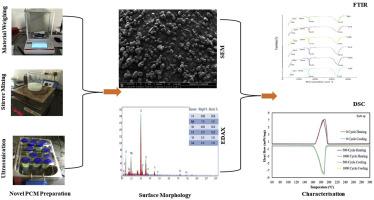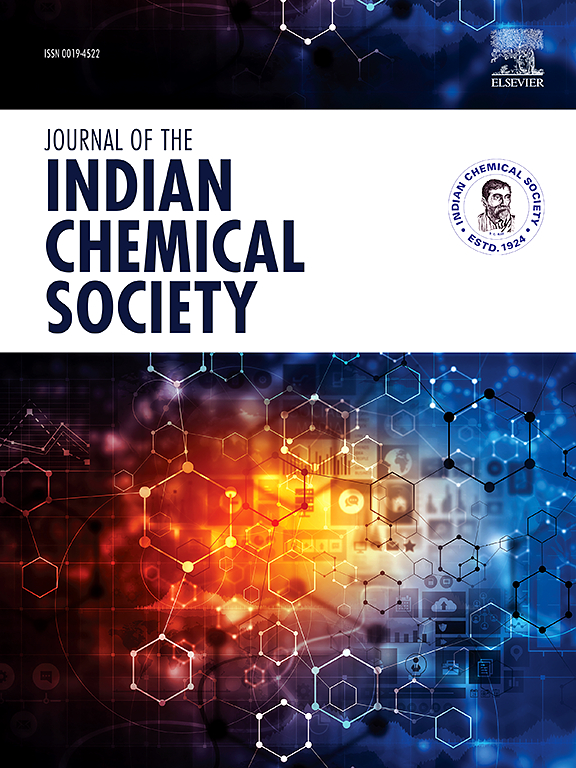Development, characterization and themo-physical analysis of energy storage material doped with TiO2 and CuO nano-additives
IF 3.2
4区 化学
Q2 CHEMISTRY, MULTIDISCIPLINARY
引用次数: 0
Abstract
The paper presents the results of an experimental investigation on chemical stability, surface morphology, and thermo-physical properties of phase change material integrated with nano additives. The research aims to evaluate impact of varying nano-particle concentration on thermal performance of phase change material. The phase change material magnesium dichloride hexahydrate and potassium chloride mixed in different mass ratio along with different wt% concentration of nano-additives titanium dioxide and copper oxide to prepare novel phase change material. Characterization methods such as Fourier Transform Infrared Spectroscopy, Scanning electron microscope, Energy-dispersive X-ray analysis, and Differential scanning calorimeter analysis were employed. The Fourier transform infrared spectra indicated physical interactions between phase change material and nano-additives, while Energy-dispersive X-ray analysis confirmed elemental composition, and Scanning electron microscope demonstrated uniform distribution. The improved thermal properties of samples were reflected in their phase change enthalpy (284.57 J/g to 324.63 J/g), minimal energy loss (0.91 %–2.96 %), and low supercooling (0.3 %–5.26 %). Notably, doping with 1.5 wt% of titanium dioxide and copper oxide enhanced thermal conductivity by up to 117.07 % and specific heat capacity by up to 48.09 %. The introduction of nanoparticles significantly improves heat transfer characteristics, resulting in enhanced energy retention, reduced energy loss during phase transitions, decreased supercooling, and increased physical stability. These results suggest that optimized phase change material with nano-additives is highly effective for applications requiring stable and efficient thermal management.

掺杂 TiO2 和 CuO 纳米添加剂的储能材料的开发、表征和物理分析
本文介绍了对加入纳米添加剂的相变材料的化学稳定性、表面形态和热物理性能的实验研究结果。研究旨在评估不同纳米颗粒浓度对相变材料热性能的影响。将相变材料六水二氯化镁和氯化钾以不同的质量比与不同重量百分比浓度的纳米添加剂二氧化钛和氧化铜混合,制备新型相变材料。表征方法包括傅立叶变换红外光谱、扫描电子显微镜、能量色散 X 射线分析和差示扫描量热仪分析。傅立叶变换红外光谱显示了相变材料与纳米添加剂之间的物理相互作用,能量色散 X 射线分析确认了元素组成,扫描电子显微镜显示了均匀分布。样品热性能的改善体现在其相变焓(284.57 J/g 至 324.63 J/g)、最小的能量损失(0.91 %-2.96 %)和较低的过冷度(0.3 %-5.26 %)。值得注意的是,掺入 1.5 wt% 的二氧化钛和氧化铜后,热导率提高了 117.07 %,比热容提高了 48.09 %。纳米粒子的引入显著改善了传热特性,从而增强了能量保持能力,减少了相变过程中的能量损失,降低了过冷度,并提高了物理稳定性。这些结果表明,含有纳米添加剂的优化相变材料对于需要稳定高效热管理的应用非常有效。
本文章由计算机程序翻译,如有差异,请以英文原文为准。
求助全文
约1分钟内获得全文
求助全文
来源期刊
CiteScore
3.50
自引率
7.70%
发文量
492
审稿时长
3-8 weeks
期刊介绍:
The Journal of the Indian Chemical Society publishes original, fundamental, theorical, experimental research work of highest quality in all areas of chemistry, biochemistry, medicinal chemistry, electrochemistry, agrochemistry, chemical engineering and technology, food chemistry, environmental chemistry, etc.

 求助内容:
求助内容: 应助结果提醒方式:
应助结果提醒方式:


